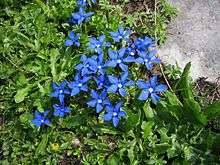Gentiana verna
| Gentiana verna | |
|---|---|
| | |
| Scientific classification | |
| Kingdom: | Plantae |
| (unranked): | Angiosperms |
| (unranked): | Eudicots |
| (unranked): | Asterids |
| Order: | Gentianales |
| Family: | Gentianaceae |
| Genus: | Gentiana |
| Species: | G. verna |
| Binomial name | |
| Gentiana verna L. | |
The spring gentian (Gentiana verna) is a species of the genus Gentiana and one of its smallest members, normally only growing to a height of a few centimetres.
The short stem supports up to three opposing pairs of elliptical or lanceolate leaves. The conspicuous vivid blue (sometimes purplish-red or rarely white)[1] flowers are 1–2 cm in diameter, with a deeply five-lobed corolla; they are produced in late spring to early summer.[1] The flowers attract butterflies and bees (particularly bumblebees) for pollination. Ants are responsible for the spreading of its seeds.
Distribution

G. verna is one of the most widespread gentians, found on sunny alpine meadows throughout Eurasia from Ireland to Russia. It is common in central and southeastern Europe, such as in low mountain ranges like the Jura and Balkans, and up to an altitude of 2,600 metres (8,500 ft). It is also to be found in mountainous regions ranging from the High Atlas of Morocco to the mountains of Turkey, Iraq and Iran. In northern Europe, it is very rare, confined to Teesdale in northern England and a handful of locations in western Ireland.[1] It tends to thrive on dry meadows with chalky soil; it is also known to grow in silicaceous soils. Its scarcity has led to protection in a number of European countries as an endangered species.
Symbolism
It is the county flower of Durham in the United Kingdom.[2] It was first found in Britain by John Harriman.[3]
A drawing of Gentiana verna by Holly Somerville is the logo for the botany department in Trinity College Dublin. [4]
Gentiana verna appeared on the design of a Great Britain stamp, issued in 1964 to mark the 10th International Botanical Congress held in Edinburgh.
A number of superstitions are associated with the Spring Gentian. For example, it is considered bad luck to bring the gentian into a house, as the individual would risk being struck by lightning. Also, folklore suggested that death would follow if the flower was ever picked.
It features, in its Latin name, in the eulogy of the Serbian soldiers who died for the liberation of Southern Serbia (now the Republic of Macedonia) from Bulgarians and Austro-Hungarians at the end of World War I, on whose graves in the mountains of Kajmakčalan they grow, written by Stevan Jakovljević, writer and botanist, rector of the Belgrade University in 1945-50.
References
- 1 2 3 Pardoe, H. S. Mountain Plants of the British Isles. National Museum of Wales. p. 24. ISBN 978-0-7200-0423-6.
- ↑ Plantlife website County Flowers page
- ↑
 Stephen, Leslie; Lee, Sidney, eds. (1890). "Harriman, John". Dictionary of National Biography. 24. London: Smith, Elder & Co.
Stephen, Leslie; Lee, Sidney, eds. (1890). "Harriman, John". Dictionary of National Biography. 24. London: Smith, Elder & Co. - ↑ "plant sciences at Trinity College Dublin". blogspot.ie. Retrieved 12 May 2016.
External links
| Wikimedia Commons has media related to Gentiana verna. |